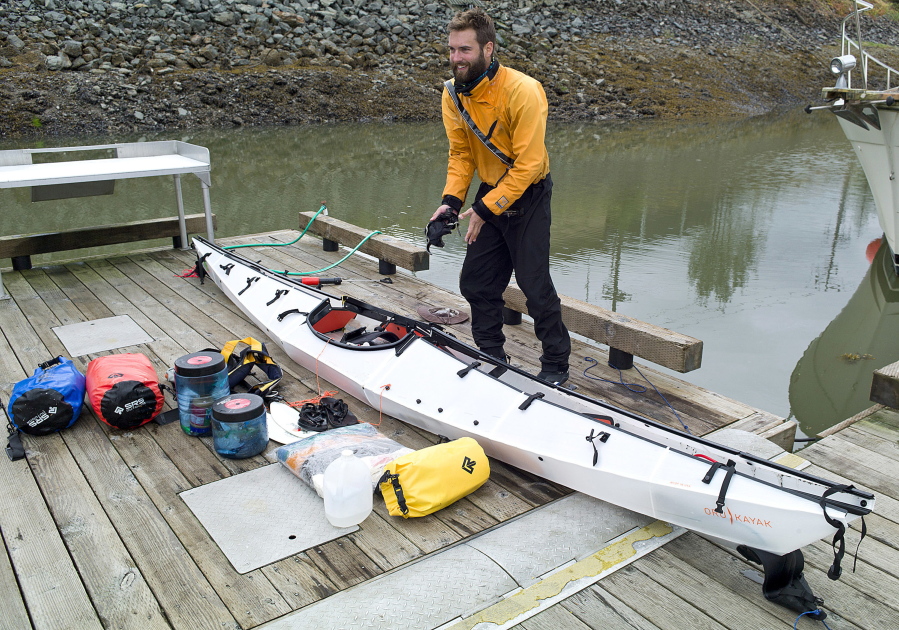JUNEAU, Alaska (AP) — Below the gangway leading down to Harris Harbor, 25-year-old medical student Austin Jones split open his foldable kayak, revealing among water bottles, camping and survival gear two canisters: one of Nutella and one of peanut butter.
“Peanut butter and Nutella are pretty much the best foods you can pack in terms of caloric intake,” he said, standing above what looked like the plastic innards of a kayak-shaped beast. “Plus, they taste good.”
Jones should know something about caloric intake: He just spent 59 days paddling from Anacortes, Washington, to Juneau, a trip of 1,170 miles. He paddled 25 miles and seven to eight hours every day, doing it all in a foldable, rudderless kayak, reported the Juneau Empire (http://bit.ly/2b2OKhH).
“(There were) no catastrophes,” Jones said. “I never flipped. The seas were pretty rough at a couple points though. The currents that come out of some of these glacial bays are the hardest to navigate. I was mindful of cases where that (the lack of a rudder) would be a problem and I knew that going into this.”
Jones’ 16-foot “origami kayak,” as the manufacturer’s website puts it, looks like it’s made out of corrugated cardboard, something more suited to campaign signs than open seas. The kayak lacks a rudder and a “skeg,” an adjustable fin that helps the boat control wind and current.
The kayak’s manufacturer, Oru Kayak, funded and built the origami design using a Kickstarter fund, which attracted 238 backers who pledged $356,507 to help bring the project to life. Jones said the boat posed no issues during his trip outside of its design limitations.
Jones started the trip with two companions, both fellow medical students who had to bow out of the end of the trip. One flew out of Ketchikan to attend a sister’s wedding, the other left a few weeks before the end of the trip to have a bit of a “normal summer” before medical school started again. Jones, who has never been to Alaska, was trying to make it as far as he could in two months. Juneau was the closest ferry stop he could make before the first day of school in August.
Before landing in Juneau, Jones hunkered down in Tracy Arm for a few days waiting out bad weather. He was accompanied by a generous sailboat crew.
“They gave me crab cakes, salmon and halibut and let me sleep on their boat for a couple of days when the weather was bad. They even offered to take me the last 50 miles to town if the weather didn’t lift,” Jones said. “To get here so many people helped me along the way.”
Jones and his companions made stops in Bella Bella, B.C.; Prince Rupert, B.C.; and Ketchikan, Wrangell, Petersburg and Juneau, Alaska.
“Coming from a backpacking experience to kayaking offered a different perspective of nature and the wild. I came within 10 feet of an orca, and a humpback whale breached right in front of me. I came away with more appreciation of the ocean and weather, of having to make quick decisions about safety when the weather turns and every stroke counts,” Jones said.
Though the trip was a success, camping for 59 days with extremely limited gear space has its drawbacks. The worst part: “having to wear the same T-shirt and boxers every day, climbing into my nasty wetsuit every morning,” Jones said.
Jones is in his second year of med school at Tulane University in Louisiana and plans to work in the field of infectious diseases when he graduates. Though he lamented the end of the adventure, he is looking forward to the normalcy of starting school again.
“I think it’ll be great. It’s nice to have a plan when I get home. … It’ll be nice to have everything planned for me,” he said.
Before Jones could get the origami kayak folded up for his 4 a.m. ferry out of Juneau, a man walked down the gangway and stopped by his gear. Raising an eyebrow, he pinched the kayak between his thumb and forefinger.
“I wouldn’t trust my life with that,” he said.



